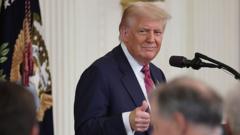With President Trump's insistence on higher defense spending for NATO allies, European nations are pivoting to a new spending strategy. In a move to satisfy the U.S. call for enhanced funding, several member countries have agreed to extend their military budget to 3.5 percent of their GDP while also incorporating an additional 1.5 percent for innovative, nontraditional defense expenses by 2032. This reimagined approach will cover essential infrastructure improvements, cybersecurity advancements, and cutting-edge military technology.
**NATO Strives for Creative Solutions Amidst Security Demands**

**NATO Strives for Creative Solutions Amidst Security Demands**
As NATO faces pressure to boost military spending, member countries are exploring unconventional solutions to redefine their security budget.
NATO’s Secretary General, Mark Rutte, highlighted the critical necessity of ensuring all defense-related spending is robust and reliable, especially in light of evolving geopolitical threats. In a recent meeting, he emphasized the importance of bolstering existing infrastructure to support military operations safely.
European leaders are expressing a willingness to bear greater costs amid concerns over future U.S. military support—an essential pillar of European security. This financial strategy reflects a broader trend of adapting to contemporary military challenges and ensuring that defense capabilities evolve alongside technological advancements.
In summary, as NATO members redefine military expenditure to include innovative defense measures, they are focusing on long-term security enhancements while addressing fiscal pressures from the United States.
European leaders are expressing a willingness to bear greater costs amid concerns over future U.S. military support—an essential pillar of European security. This financial strategy reflects a broader trend of adapting to contemporary military challenges and ensuring that defense capabilities evolve alongside technological advancements.
In summary, as NATO members redefine military expenditure to include innovative defense measures, they are focusing on long-term security enhancements while addressing fiscal pressures from the United States.






















